- Arms
- Arms with thick, undulating protective membranes.
- Large suckers may occupy mid-regions of arms (most apparent on arms II) but sucker pattern probably variable.
- Arms with thick, undulating protective membranes.
- Tentacles
- Club length ca. 70-80% of tentacle length.
- Base of club long, tapers gradually.
- Club suckers minute (0.05 mm) with smooth inner rings.
- Tentacle not completely surrounded by suckers even at tip.
- Protective membranes present but very low.
 Click on an image to view larger version & data in a new window
Click on an image to view larger version & data in a new window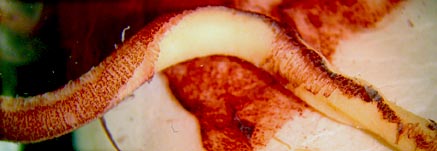
Figure. Oral and lateral views of the elongate basal region of the tentacular club of Mg. magna, 160 mm ML, 39°59'N, 67°20'W, as the sucker-bearing region narrows as it loops around this twisted and damaged tentacle. Photograph by R. Young
 Click on an image to view larger version & data in a new window
Click on an image to view larger version & data in a new window
Figure. The extreme proximal end of the tentacular club of Mg. magna, 111 mm ML. The sucker-bearing region has broken up into a series on small patches (groups of red dots). Proximal direction is to the left. Photograph by R. Young.
 Click on an image to view larger version & data in a new window
Click on an image to view larger version & data in a new window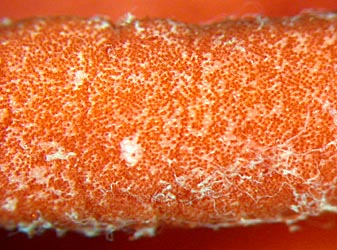
Figure. Oral view of the mid-region of the tentacular club of Mg. magna, 160 mm ML. Photograph by R. Young.
- Head
- Eyelid with anterior optic sinus.
- Olfactory organ on short stalk wider than sensory dome.
- Eyelid with anterior optic sinus.
- Funnel
- Funnel pocket absent.
- Funnel pocket absent.
- Fins (Joubin, 1920)
- Fin length (without tail) 66% of ML.
- Fin width 79% if ML (without tail); assumming a 20 mm tail the FW becomes 71% of ML
- Fin width 120% of fin length (without tail).
- Tubercules
- Skin tubecules absent.
- Skin tubecules absent.
- Photophores
- Photophores absent.
- Photophores absent.
- Pigmentation
- Arms with dense chromatophores aborally, epithelial pigmentation orally.
- Head, funnel, mantle and fins with dense chromatophores.
- Most pigment beyond oral region in chromatophores.
 Click on an image to view larger version & data in a new window
Click on an image to view larger version & data in a new window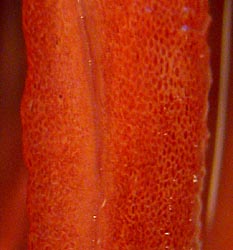

Figure. Segments of arm II of Mg. magna, 111 mm ML. Left - Aboral view showing pigmentation and keel. Right - Lateral view showing the abrupt change in pigmentation from chromatophores (aboral half) to epithelial pigment (oral half). Groove on left side of photograph is an artifact. Photograph by R. Young.
- Measurements
Source Joubin, 1920 Dive 3750 13°07'S, 09°02'W 39°59'N, 67°20'W Sex Unknown Imm. female Imm. female Imm. female Mantle length 160 111 70 160 Mantle width 54 -- 15 Head length 42 -- -- Head width 43 27 -- 30 Eye diameter 15.8 -- 22 Fin length (without tail) 105
68 43 90 Fin width 127 71 51 96 Tail length 15 6 18 Arm I, length 80 52 33 70- Arm II, length 105 69 42 86 Arm III, length 82 58 44 73 Arm IV, length 172 124 100 147 Arm I, sucker no. 135 -- -- Arm II, sucker no. 120, -- -- Arm III, sucker no. 112 -- -- Arm IV, sucker no. 109 -- -- Tentacle length 480 200 300 265 Club length 390 157 202 200
Comments
The color of most of the photographs above have been artificially changed slightly and lightened to see details. Actual color is very deep, bright red.
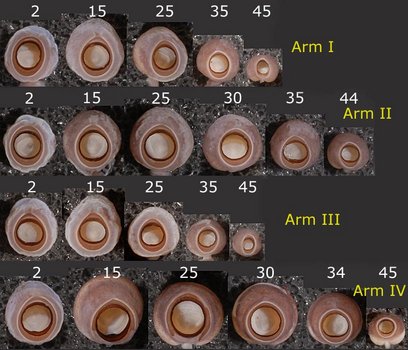



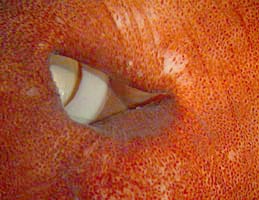
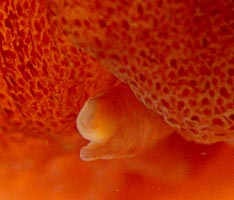




 Go to quick links
Go to quick search
Go to navigation for this section of the ToL site
Go to detailed links for the ToL site
Go to quick links
Go to quick search
Go to navigation for this section of the ToL site
Go to detailed links for the ToL site